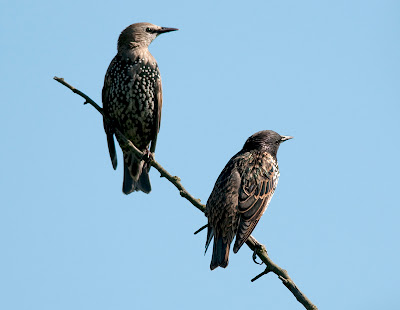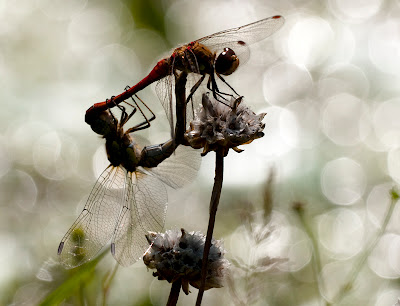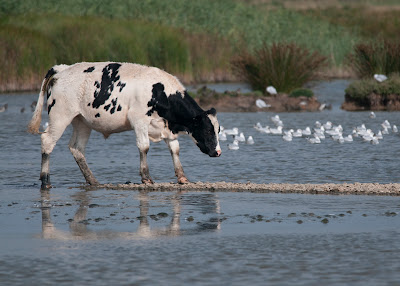Plenty of Ruddy Darters about, a few even posing on things other than the unphotogenic boardwalk.
Also representing dragon-kind - Common Darters, and of course Migrant Hawkers which were noticeably more numerous than they were a couple of weeks ago (though still not up to the ridiculous levels of last September).
The buddleias near the Tower Butts hide were stuffed with Small Torties, plus a couple of Peacocks. No Jersey Tigers today though.
From the same spot, I was very happy to find two Whinchats. No other passerine migrants around today, though there have been Wheatears and Black Redstarts reported recently.
Lots of tiny young Marsh Frogs around today, and they seem much more confiding than their bigger and older relatives.
Big Starling flocks out on the fields - it was interesting to see a juvenile posing alongside an adult - not too much difference between them now.
A rose bedeguar gall aka 'robin's pincushion', which I have discovered is produced by the wasp Diplolepis rosae.
And that's Rainham. There was also at least one Hobby about and I saw but couldn't photograph a high-speed Clouded Yellow. No waders of note. Now on to today's look at Sevenoaks Wildlife Reserve, which I visited between 12-3pm because it was at that time that Robert on the RSPB forums got some very nice shots of a Kingfisher from Willow hide. I had expected to find the hide busy but in fact had it entirely to myself for more than an hour.
I noticed a young Grey Heron up a tree on the left-hand island, doing some yogic stretches. Then it flew down to land in the shallow water, and began to slink from left to right, clearly hunting but as far as I could see not managing to catch anything.
In between birds, I tried to photograph the various tandem pairs of darters that were going round egg-laying in the shallows.
It was a half-hour wait before the first Kingfisher arrived. It flew teasingly in a loop around the middle island before settling on the walking stick-shaped stick, from where it fished (like the heron, mostly without success). I took tons of pics of it perched, and fluked a couple of flight shots (no 'splash' pics though - there's always something to keep a photographer going back!). It stayed maybe 10 minutes, then left, then came back for another five minutes of fishing.
Not much else showed up here. A Clouded Yellow flew across the lake, and a trio of Gadwalls landed at the back. I decided to forget about birds and spent the rest of my time photographing plants and insects. The Purple Loosestrife is out and looking lovely, the Common Carder Bumblebees seem to love it.
A closer look at the purple stuff. The flowers are wonderfully ill-disciplined and 'blowsy' when you look closely.
It seems to have been a bad year for ladybirds, even the Harlequins. Saw just one today - in other recent years any summer visit would produce loads of sightings of adults and larvae.
Butterflies today, besides the afore-mentioned Clouded Yellow, were lots of Speckled Woods, one Red Admiral, Large and Small Whites and one tiny browny lycaenidy thing that I didn't get a decent look at, which could have been any of Small Copper, Brown Argus or female Common Blue. The Speckled Woods were being complete stars, allowing me to get very close with the BigMac lens and only taking off when they needed to chase another butterfly out of their territory.
Back in the wildlife garden, I actually saw these two Common Darters meet each other and have an extremely whirlwind romance in midair, before they came crashing down together onto vegetation by the little pond.
I tried a backlit shot from the other side. I quite like those starburst blobs but from what I've heard most photographers hate them...
Overhead, a male Brown Hawker was hawking about, moving in the extremely unpredictable manner that is typical for this (annoying) species. But I finally caught it against the sky for a (nearly) sharp photo.
And then - wonders will never cease - it actually landed! Where I could see it! It chose about the shadiest spot possible but hey, it's still only the second time I've managed perched pics of this species. A most satisfactory end to the visit.





























































